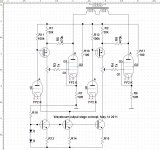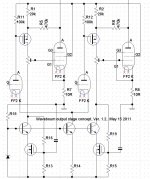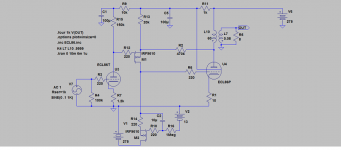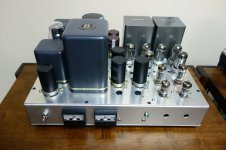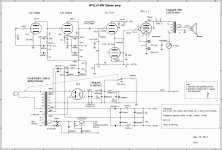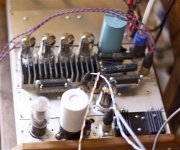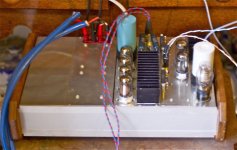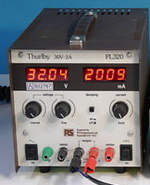Ok. So at higher collector current, slew rate is better which should favour to reduce distortion produced by driving 4P1L input however the BJT distortion is higher given increased base current. This explains now what I found that HF distortion continued to grow exponentially despite the addition of the follower, albeit reduced significantly by the follower. This meant that the BJT distortion was causing it. Now, if I reduce the collector current (and have only the follower input capacitance rather than the miller capacitance of the 4P1L) I should find a point where the distortion of the BJT is lower (as experienced briefly this morning). I will play with R3+RE to get this and retain -9V for VEE.
I also noticed the harmonic cancellation, specially for H2 between 1 - 5kHz, whereas at higher frequencies, it was a clear H2, H3, H4 progressive decay spectrum. I suppose this should have a sonic impact which is not what we all want. Anyhow, need to adjust and listen to.
Thanks!
Ale
I also noticed the harmonic cancellation, specially for H2 between 1 - 5kHz, whereas at higher frequencies, it was a clear H2, H3, H4 progressive decay spectrum. I suppose this should have a sonic impact which is not what we all want. Anyhow, need to adjust and listen to.
Thanks!
Ale
I listened to the amp earlier this evening. I guess the listening test wasn't ideal as only tried one channel and played some CD via the Pete Millett's audio interface to drive Robustiano. But what it was worst of my setup was a simple Monacor full range SP200X driver (92dB) laying barebone on top of my workbench. Despite all this, I liked the sound. Detailed and clear. Very loud indeed, I could definitely live with 2.5-3W on this amp.
I think I need to build this properly and test it with proper speakers
So far so good...
Ale
I think I need to build this properly and test it with proper speakers
So far so good...
Ale
I did some minor tweaks by changing the MPSA42 driver bypass capacitor for a proper WIMA MKS2 10uF/63V one. Also added an additional 30uF cathode bypass oil cap to the existing 30uF in ultra-path connection. Played for some time with the feedback pot and couldn’t notice a significant difference between 38-45mA of bias anode current. I was expecting to notice this triode-like to more of a pentode-like spectrum, but that wasn’t evident to me. Perhaps is due to testing conditions, however distortion levels are low so not sure what might be.
Someone asked me how this compared to the triode 4P1L SE/PSE version. It is hard to answer the question and will be unfair to this circuit to attempt doing so given the testing conditions I put this under. The power supply has a voltage feedback-type regulator and never sounded great. The filaments are also powered up by a simple DC supply, no Rod Coleman regulators here, however, this is very quiet. What is even worse, the driver is a bare-bone Monacor SX200 full range that hasn’t had a proper burn-in process.
Despite all this, I can say I like the sound of Robustiano. It's clear and balanced. No harshness on the harmonics that would normally put me off. I will probably build this properly and take it down so I can test it with the right speakers, etc.
Ale
Someone asked me how this compared to the triode 4P1L SE/PSE version. It is hard to answer the question and will be unfair to this circuit to attempt doing so given the testing conditions I put this under. The power supply has a voltage feedback-type regulator and never sounded great. The filaments are also powered up by a simple DC supply, no Rod Coleman regulators here, however, this is very quiet. What is even worse, the driver is a bare-bone Monacor SX200 full range that hasn’t had a proper burn-in process.
Despite all this, I can say I like the sound of Robustiano. It's clear and balanced. No harshness on the harmonics that would normally put me off. I will probably build this properly and take it down so I can test it with the right speakers, etc.
Ale
In your 4.2v regulator circuit, did you mean to use a cap from base to ground or did you mean to use in a zener diode? I can't see how that portion of the power supply would function.
Battery biased 4P1L x 3 PSE Single stage stereo amp
As I have got the pre-ordered OPT (XE-20s) from ISO-Tango in last December. So I decided to build a 4P1L x 3 PSE Single stage Stereo amp (experimental) as I do have a pre-amp which can deliver higher output voltage (over 70V rms) and condenser coupled output), yet with low impedance.
At first, I tried grid leak resister 200K ohm for fixed bias as a standard circuitry, and its output power came out only 4.5W due to the fact of the grid current starts flowing out, so that its bias voltage heads to deeper. It should be pointed out that this 4P1L tends specifically to flow out grid current..
Then, I made another try to replace the grid leak resister with a grid choke.
The outcome was of a minor improvement because of the bias PSU was not strong enough for sustaining lower impedance status...
Finally, I introduced an idea of Battery (14 units of size AA Battery in series for 21 V). Fortunately, the output power jumped up to 7W, and that its sound became further upgraded namely in clarity!
In your 4.2v regulator circuit, did you mean to use a cap from base to ground or did you mean to use in a zener diode? I can't see how that portion of the power supply would function.
The circuit is not voltage regulator, but functioning for ripple suppressor.
All of my DHT transmitting tube amps adopted above circuit.
Single-ended triode Amps using zero-bias transmitting tubes
Hiro
Hi Anatoly,
Good to see you around here
Clever idea of using a FET as the coupling device in this way. You can easily get the feedback ratio between two resistors without using the ro of the FET/BJT which varies from device to device (specially on FETs).
What is the difference between the CCS and gyrator load between your two designs?
I must definitely try this!
P.S. I'm insisting Ronald Dekker to introduce a "Schade feedback" curve tracing mode in the uTracer v3. He just introduced the ultralinear mode, just a question of a few code updates
would be great to trace some curves this way.
cheers
Ale
Good to see you around here
Clever idea of using a FET as the coupling device in this way. You can easily get the feedback ratio between two resistors without using the ro of the FET/BJT which varies from device to device (specially on FETs).
What is the difference between the CCS and gyrator load between your two designs?
I must definitely try this!
P.S. I'm insisting Ronald Dekker to introduce a "Schade feedback" curve tracing mode in the uTracer v3. He just introduced the ultralinear mode, just a question of a few code updates
would be great to trace some curves this way.
cheers
Ale
A modified version of the previous introduced 4P1Lx3 amp
In order to set up for lower voltage input e.g. lower than 1V, I attempted to insert 2 stage voltage amplifier to the former 4P1Lx3 single stage amp (#746).
As a result, it was made known that the distortion (THD) level has lowered considerably, because of cancelation of 2`nd harmonics worked.
At the same time, it was confirmed of the wider frequency response with no NFB amp.
For the first week I have been listening high resolution sources with this amp and I feel it comfortable at warmth and clarity.
THD: 8W:3.4%, 2W:0.21%, 1W:0.11%, 0.1W:0.028%
Frequency response: 20Hz:-0.4dB, 100kHz:-5.2dB
D/F: 2.5
Residual noise: 0.13mV
Hiro
I replaced the battery biasing with a7119 as a direct coupling cathode follower with CCS on my experimental 4P1L PSE amp and that the plate voltage on the 4P1L raised to ca 280V in A2 class.
As a result, the output was increased to 10W with non clipping and that its THD has been improved in all output ranges.
The 4P1Ls in use are running in between 8.5W~9W of plate dissipation.
For verify the durability of 4P1Ls, I shall continue to run on the above conditions for the time being.
In order to set up for lower voltage input e.g. lower than 1V, I attempted to insert 2 stage voltage amplifier to the former 4P1Lx3 single stage amp (#746).
As a result, it was made known that the distortion (THD) level has lowered considerably, because of cancelation of 2`nd harmonics worked.
At the same time, it was confirmed of the wider frequency response with no NFB amp.
For the first week I have been listening high resolution sources with this amp and I feel it comfortable at warmth and clarity.
THD: 8W:3.4%, 2W:0.21%, 1W:0.11%, 0.1W:0.028%
Frequency response: 20Hz:-0.4dB, 100kHz:-5.2dB
D/F: 2.5
Residual noise: 0.13mV
Hiro
Attachments
Hi there - if you build my PSE 4P1L I'm pretty sure you'll like it. It's a bit special on things like vocals - very transparent and lifelike. I listen to a lot of vocals and opera so it's a constant pleasure. Don't cut corners, though, it needs to be fully optimised. Andy
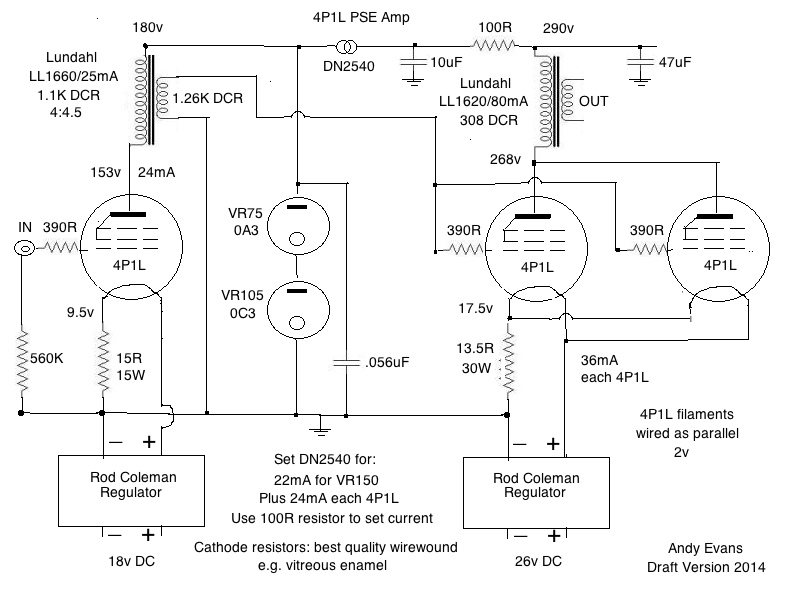
Hi Andy.
Are you using your amp,with your 26, or with your 4P1L pre ??
Do you mind to share a picture of you PSU chassic. ??
Can this be made using a 5K Single Ended Output Trafo. I own this sowter , http://www.sowter.co.uk/specs/se09.htm . ??
You might use 4 Rod Coleman Regulators, with 4 filament trafos isn't that correct ??
What is the purpose of the VR105 + VR75 tube voltages regulator. Can see from an older schematic that you now have added
the VR75 too. Takes up more space ??
How do you handle the microphonic issue. Isn't it a problem like in the 4P1L line stage ???
Hopefully not to many questions.
/Thanks Michael
Last edited:
Hi - I do not have a preamp. I don't need it. I have Mark Audio Alpair 10 speakers, single units, and the amplification is enough out of my ES9023 DAC. So just this 2 stage amp. Very minimal. For the OPT, what you need is 80mA gap. 3K is good or 3.5K, and 5K is possible also but it must be gapped for at least 80mA.
Yes, I use 4 Rod's regulators with separate supplies to each tube. I either use choke input filament supply or Thurlby Thandar 30v 2A bench supplies. The purpose of VR105+VR75 is to get 180v for the input section as you can see.
I don't get microphonics because:
1. I have 2v in from my DAC so it isn't handling small signals
2. My chassis is 4mm aluminium everywhere, very solid.
3. I starve the filaments a little on the input.
I've used this amp almost 24/7 for 2 years now. It's been very reliable. I've changed the tubes twice in 2 years. I bought a lot of 4P1L so I will never be short of them!! No need to ever buy any more tubes. Unless a really good design appears to better this, I've stopped building hi-fi altogether! I just listen now.
Andy
Yes, I use 4 Rod's regulators with separate supplies to each tube. I either use choke input filament supply or Thurlby Thandar 30v 2A bench supplies. The purpose of VR105+VR75 is to get 180v for the input section as you can see.
I don't get microphonics because:
1. I have 2v in from my DAC so it isn't handling small signals
2. My chassis is 4mm aluminium everywhere, very solid.
3. I starve the filaments a little on the input.
I've used this amp almost 24/7 for 2 years now. It's been very reliable. I've changed the tubes twice in 2 years. I bought a lot of 4P1L so I will never be short of them!! No need to ever buy any more tubes. Unless a really good design appears to better this, I've stopped building hi-fi altogether! I just listen now.
Andy
Hi - I do not have a preamp. I don't need it. I have Mark Audio Alpair 10 speakers, single units, and the amplification is enough out of my ES9023 DAC. So just this 2 stage amp. Very minimal. For the OPT, what you need is 80mA gap. 3K is good or 3.5K, and 5K is possible also but it must be gapped for at least 80mA.
Yes, I use 4 Rod's regulators with separate supplies to each tube. I either use choke input filament supply or Thurlby Thandar 30v 2A bench supplies. The purpose of VR105+VR75 is to get 180v for the input section as you can see.
I don't get microphonics because:
1. I have 2v in from my DAC so it isn't handling small signals
2. My chassis is 4mm aluminium everywhere, very solid.
3. I starve the filaments a little on the input.
I've used this amp almost 24/7 for 2 years now. It's been very reliable. I've changed the tubes twice in 2 years. I bought a lot of 4P1L so I will never be short of them!! No need to ever buy any more tubes. Unless a really good design appears to better this, I've stopped building hi-fi altogether! I just listen now.
Andy
Hi Andy.
Just to sum things up.
You don't take extra precautions, regard the microphonic else than having a heavy chassic with 4mm alu plate ??
Reason I asked is because the things I have to go through with my 4P1L preamp regards the microphonic.
Do you think my sowter could be used, link to datasheet here
SE09 SINGLE ENDED OUTPUT TRANSFORMER ??
Please post some pictures of your build, else PM them to me. Would very much like to see how you handle the space consideration with all these things inside ??
/Thanks Michael.
Looks like the Sowter is gapped for 95mA so that will be fine. You could even use 3 x 4P1L if you decreased the current to 30mA on the output tubes, but with that it would be better to have a 2.5K OPT. It has 4/8/16 ohm taps, so you could play around with those depending on what impedance your speakers are.
Here's the amp. It only has one VR tube by the white capacitor because my LL1660 is 18mA not the preferred 25mA, so I have 150v going into it. The 25mA version is the one to have. The power supplies are in different chassis of course. The connectors are XLR 4-pin for the filaments and Speakon 4-way for the HT.
Here's the amp. It only has one VR tube by the white capacitor because my LL1660 is 18mA not the preferred 25mA, so I have 150v going into it. The 25mA version is the one to have. The power supplies are in different chassis of course. The connectors are XLR 4-pin for the filaments and Speakon 4-way for the HT.
Attachments
Last edited:
Thanks Andy.
My Sowter has only 8 Ohm , but it's fine for my Tannoy HPD-385A.
Can see that you have mounted the 4P1L tubes directly on the chassic. And this is not a problem with microphonic I guess
Do you have a picture of your PSU case/chassic ??
Which filament Trafo's are you using for "Rod Colenam" ??
I need to find some which are not that huge
My Sowter has only 8 Ohm , but it's fine for my Tannoy HPD-385A.
Can see that you have mounted the 4P1L tubes directly on the chassic. And this is not a problem with microphonic I guess
Do you have a picture of your PSU case/chassic ??
Which filament Trafo's are you using for "Rod Colenam" ??
I need to find some which are not that huge
I use Beyma 15XT which are 97dB sensitive . I mount my 4P1L on those little black steel 'shockproof' plates which use grommets for isolation . You can find these on Ebay . I get noises if I tap the valves with a screwdriver , although I do find at times when I pause the music there are some ringing noises through the speakers . I now use either multiples of viton 'O' rings on the valves or Pearl coolers . There is some mechanical noise from the 4P1L themselves at warmup but apart from that , these valves are fine if correctly treated . I would suggest if not using a subchassis for the 4P1L , to add some damping on the underside of the top plate . Rubber roofing underlay is good for this (and cheap)
316a
316a
Everybody has different ideas about power supplies so I don't usually specify them.
Rod recommends these transformers:
JMS Manufacturing
I just use whatever I have - I think a toroid which is not ideal, but it is followed by a choke Hammond 159ZC. Very useful choke. I recommend those. I buy from Bluebell Audio. They can get in chokes that are not on the list.
Untitled Document
I use these a lot - Thurlby Thander PL320 bench supplies 30v 2A. I get them off ebay. Or you can use a similar one. Good for experiments and sound as good as a choke input supply.
Rod recommends these transformers:
JMS Manufacturing
I just use whatever I have - I think a toroid which is not ideal, but it is followed by a choke Hammond 159ZC. Very useful choke. I recommend those. I buy from Bluebell Audio. They can get in chokes that are not on the list.
Untitled Document
I use these a lot - Thurlby Thander PL320 bench supplies 30v 2A. I get them off ebay. Or you can use a similar one. Good for experiments and sound as good as a choke input supply.
Attachments
Last edited:
I use Beyma 15XT which are 97dB sensitive . I mount my 4P1L on those little black steel 'shockproof' plates which use grommets for isolation . You can find these on Ebay . I get noises if I tap the valves with a screwdriver , although I do find at times when I pause the music there are some ringing noises through the speakers . I now use either multiples of viton 'O' rings on the valves or Pearl coolers . There is some mechanical noise from the 4P1L themselves at warmup but apart from that , these valves are fine if correctly treated . I would suggest if not using a subchassis for the 4P1L , to add some damping on the underside of the top plate . Rubber roofing underlay is good for this (and cheap)
316a
Do you talk about 4P1L as PSE, or do you refer to 4P1L as preamp.
I have a 4P1L preamp, so I'm aware of microphonics, where I use rubber "silent-block" to deal with it.
BUT is the microphonics also an issue as a PSE amp ???
Everybody has different ideas about power supplies so I don't usually specify them.
Rod recommends these transformers:
JMS Manufacturing
I just use whatever I have - I think a toroid which is not ideal, but it is followed by a choke Hammond 159ZC. Very useful choke. I recommend those. I buy from Bluebell Audio. They can get in chokes that are not on the list.
Untitled Document
I use these a lot - Thurlby Thander PL320 bench supplies 30v 2A. I get them off ebay. Or you can use a similar one. Good for experiments and sound as good as a choke input supply.
Hi Andy.
I have a labor PSU myself, but I was thinking of a Filament PSU, more convenient for build in.
I'm searching for some ELMA, have used them for my 4P1L preamp, just need them not to be TOO big.
This could be my new friend...
http://www.conrad-electronic.co.uk/...ma-TT-IZ-64-528VA-Transformer-12-14-16-18-24V
Last edited:
Hi Michael,
I have a PSE similar to Andy's. Except I use a LL1692a in 1:1.75 configuration
In order to get a 1Vrms input sensitivity. It helps when you source has less then
2Vrms out.
In my experience I get some light micro phonics from the 4p1l driver but manageable. I use 3mm top plate and very heavy Brazilian cherry wood cabinet. I also attached all sockets using rubber grommets. You can see picture of my implementation if you go on my blog.
I also built Ale's Siberian gen 3 and I can tell you that the PSE sounds better without the preamp. I guess there are too many 4P1l in the chain.
I also tried toroidal transformers for filament supply but I didn't like sound so I am using now dual bobbin type transformers.
Best,
Radu
I have a PSE similar to Andy's. Except I use a LL1692a in 1:1.75 configuration
In order to get a 1Vrms input sensitivity. It helps when you source has less then
2Vrms out.
In my experience I get some light micro phonics from the 4p1l driver but manageable. I use 3mm top plate and very heavy Brazilian cherry wood cabinet. I also attached all sockets using rubber grommets. You can see picture of my implementation if you go on my blog.
I also built Ale's Siberian gen 3 and I can tell you that the PSE sounds better without the preamp. I guess there are too many 4P1l in the chain.
I also tried toroidal transformers for filament supply but I didn't like sound so I am using now dual bobbin type transformers.
Best,
Radu
Hi Michael,
I have a PSE similar to Andy's. Except I use a LL1692a in 1:1.75 configuration
In order to get a 1Vrms input sensitivity. It helps when you source has less then 2Vrms out.
I also built Ale's Siberian gen 3 and I can tell you that the PSE sounds better without the preamp. I guess there are too many 4P1l in the chain.
I also tried toroidal transformers for filament supply but I didn't like sound so I am using now dual bobbin type transformers.
Best,
Radu
Thanks Radu - that's exactly my experience. The sound was much cleaner when I took out the preamp. Two stages of 4P1L are all I need - the gain is x10 per tube, so with those in the output it's quite a bit louder than 2a3, 300b etc. I don't have much spare gain - It's pretty much perfect. Just enough gain and not more than I need. My volume control is always in software on my Mac Mini which has all of my music and media on it. So no extra components for volume control. It's a very, very simple circuit overall - all the complexity is in the power and filament supplies. Interstage in approximately 1:1 and OPT. No coupling caps, no cathode bypass caps. It sounds very clean because there's very little to colour the sound!
- Home
- Amplifiers
- Tubes / Valves
- One more 4P1L SE
